
“Wall slip and melt fracture of poly(lactides)”
The wall slip and melt fracture behaviour of several commercial polylactides (PLAs) as well as their rheological properties under shear and extensional have been investigated. The PLAs have had weight-average molecular weights in the range of 104–105 g/mol and studied in the temperature range of 160–200 C. The solution properties and linear viscoelastic behaviour of melts indicate linear microstructure behaviour. PLAs with molecular weights greater than a certain value were found to slip, with the slip velocity to increase with decrease of molecular weight. The capillary data were found to agree well with linear vis- coelastic envelope once correction for slip effects was applied. The onset of melt fracture for the high molecular weight PLAs was found to occur at about 0.2 to 0.3 MPa, depending on the geometrical characteristics of the dies and independent of temperature. Addition of 0.5 wt.% of a polycaprolactone (PCL) into the PLA that exhibits melt fracture was found to be effective in eliminating and delaying the onset of melt fracture to higher shear rates. This is due to significant interfacial slip that occurs in the presence of PCL.